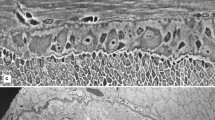Summary
Four classes of glial cells can be recognized in the central nervous system of turtles and birds on the basis of nuclear characteristics (methylene blue) and external morphology (Golgi technique). It seems likely that astrocytes and ependymal cells have a similar origin and function, but no evidence has been seen to indicate that transitional forms exist between astrocytes and oligodendrocytes or microgliacytes. Ependymal cells in the tectum and forebrain are covered by lamellate excrescences which are absent on cells in the spinal cord. Protoplasmic astrocytes are restricted to the gray matter. In the turtle they have an elongate shape characteristic of primitive elements, but stellate forms typical of mammals predominate in the bird. Fibrous astrocytes are abundant in the white matter. Endfeet are lacking in the turtle except on cells located near the pia; they are common for all elements in the bird and can sometimes be observed to outline the course of capillaries. Oligodendrocytes are identical to mammalian and amphibian forms. Small, round somata and long, thin processes are typical of types I and II while a tubular reticulum or membranous sheath characterizes type IV. The lack of a well defined somata and absence of transitional forms (type III) are compatible with the possibility that type IV is not a true cell type but corresponds to the inner cytoplasmic tongue of myelin. Microgliacytes are present in gray and white matter; they have a smaller overall size in the turtle and young chicken than in adult birds.
Similar content being viewed by others
Bibliography
Achúcarro, N.: De lévolution de la néuroglie, et spécialement de ses relations avec l'appareil vasculaire. Trab. Lab. Invest. Biol., Madr. 13, 169–212 (1915).
Brightman, M. W., and S. L. Palay: The fine structure of ependyma in the brain of the rat. J. Cell Biol. 19, 415–439 (1963).
Cammermeyer, J.: The hypependymal microglia cell. Z. Anat. Entwickl.-Gesch. 124, 543–561 (1965a).
—: VI. Histiocytes, juxtavascular mitotic cells and microglia cells during retrograde changes in the facial nucleus of rabbits of varying age. Ergebn. Anat. Entwickl.-Gesch. 38, 195–229 (1965b).
—: Morphologic distinctions between oligodendrocytes and microglia cells in the rabbit cerebral cortex. Amer. J. Anat. 118, 227–248 (1966).
De Castro, F.: Algunas observaciones sobre la histogénesis de la neuroglía en el bulbo olfativo. Trab. Lab. Invest. Biol., Madr. 18, 83–108 (1920).
Del Río Hortega, P.: Histogénesis y evolución normal; exodo y distribución régional de la microglía. Arch. Histol. (B. Aires) 5, 105–150 (1954). Reprinted from Mem. Real Soc. Esp. Hist. Nat. 11, 213 (1921).
—: Tercera aportación al conocimiento morfológico e interpretación funcional de la oligodendroglía. Arch. Histol. (B. Aires) 6, 132–183; 239–306 (1956). Reprinted from Mem. Real Soc. Esp. Hist. Nat. 14, 5–122 (1928).
—: Son homologables la glía de escasas radiaciones y la célula de Schwann? Arch. Histol. (B. Aires) 7, 1–4 (1957). Reprinted from Bol. Soc. esp. Biol. 10, 23–28 (1922).
Fleischhauer, K.: Untersuchungen am Ependym des Zwischen- und Mittelhirns der Landschildkröte (Testudo graeca). Z. Zellforsch. 46, 729–767 (1957).
Gehuchten, A. van: Contribution à l'étude de la moëlle épinière chez les vertébrés (Tropidonotus natrix). Cellule 12, 113–166 (1897).
Golgi, C.: Sulla fina anatomia degli organi centrali del sistema nervoso. Milano 1895.
Hommes, O. R., and C. P. Leblond: Mitotic division of neuroglia in the normal adult rat. J. comp. Neurol. 129, 269–278 (1967).
King, J. S.: A comparative investigation of neuroglia in representative vertebrates: A silver carbonate study. J. Morph. 119, 435–466 (1966).
Kruger, L., and D. S. Maxwell: The fine structure of ependymal processes in the teleost optic tectum. Amer. J. Anat. 119, 479–498 (1966).
Palay, S. L.: An electron microscopical study of neuroglia. In: Biology of neuroglia (W. F. Windle, ed.), p. 24–38. Springfield (Ill.): Ch. C. Thomas 1958.
Pessacq, T. P.: L'astroglie et l'oligodendroglie constituent-elles deux catégories cellulaires indépendantes ou différents degrés d'imprégnation d'un seul type cellulaire? Arch. Anat. micr. Morph. exp. 53, 169–178 (1964).
Ramón, P.: Estructura del encéfalo de camaleon. Rev. trim. microgr. 1, 46–82 (1986).
—: Nuevo estudio del encéfalo de los reptiles. Trab. Lab. Invest. Biol., Madr. 15, 83–99 (1917).
Ramón-Molinier, E.: A study on neuroglia. The problem of transitional forms. J. comp. Neurol. 110, 157–171 (1958).
Ramón y Cajal, S.: Histologie du système nerveux de l'homme et des vertébrés, vol. I Trans. Azoulay. Paris: Maloine 1909a; vol. II, 1909b.
—: Contribución al conocimiento de la neuroglía del cerebro humano. Trab. Lab. Invest. Biol., Madr. 11, 255–315 (1913).
Ramón Y Fañanás, J.: Contribución al estudio de la neuroglía del cerebelo. Trab. Lab. Invest. Biol., Madr. 14, 163–179 (1916).
Retzius, G.: Die embryonale Entwickelung der Rückenmarkeselemente bei den Ophidiern. Biol. Untersuch., N. F. 6, 41–45 (1894a).
—: Die Neuroglia des Gehirns beim Menschen und bei Säugethieren. Biol. Untersuch., N. F. 6, 1–24 (1894b).
—: Weiteres über die embryonale Entwicklung der Rückenmarkselemente der Ophidiern. Biol. Untersuch., N. F. 8, 105–108 (1898a).
—: Zur Kenntniss der Entwickelung der Elemente des Rückenmarkes von Anguis fragilis. Biol. Untersuch., N. F. 8, 109–113 (1898b).
Stensaas, L. J., and S. S. Stensaas: Astrocytic neuroglial cells, oligodendrocytes and microgliacytes in the spinal cord of the toad. I. Light microscopy. Z. Zellforsch. 84, 473–489 (1968a).
—: Astrocytic neuroglial cells, oligodendrocytes and microgliacytes in the spinal cord of the toad. II. Electron microscopy. Z. Zellforsch. 86, 184–211 (1968b).
Terrazas, R.: Notas sobre la neuroglia del cerebelo y el crecimiento de los elementos nerviosos. Rev. trim. microgr. Madr. 2, 49–65 (1897).
Vaughn, J. E., and D. C. Pease: Electron microscopy of classically stained astrocytes. J. comp. Neurol. 131, 143–154 (1967).
—, and A. Peters: Electron microscopy of the early postnatal development of fibrous astrocytes. Amer. J. Anat. 121, 131–152 (1967).
Weigert, C.: Bemerkungen über das Neurogliagerüst des menschlichen Centralnervensystems. Anat. Anz. 5, 543–551 (1890).
Author information
Authors and Affiliations
Additional information
Supported by a postdoctoral fellowship from the United States National Institutes of Health, NB 28,013-01Al.
Rights and permissions
About this article
Cite this article
Stensaas, L.J., Stensaas, S.S. Light microscopy of glial cells in turtles and birds. Z.Zellforsch 91, 315–340 (1968). https://doi.org/10.1007/BF00440762
Received:
Issue Date:
DOI: https://doi.org/10.1007/BF00440762




